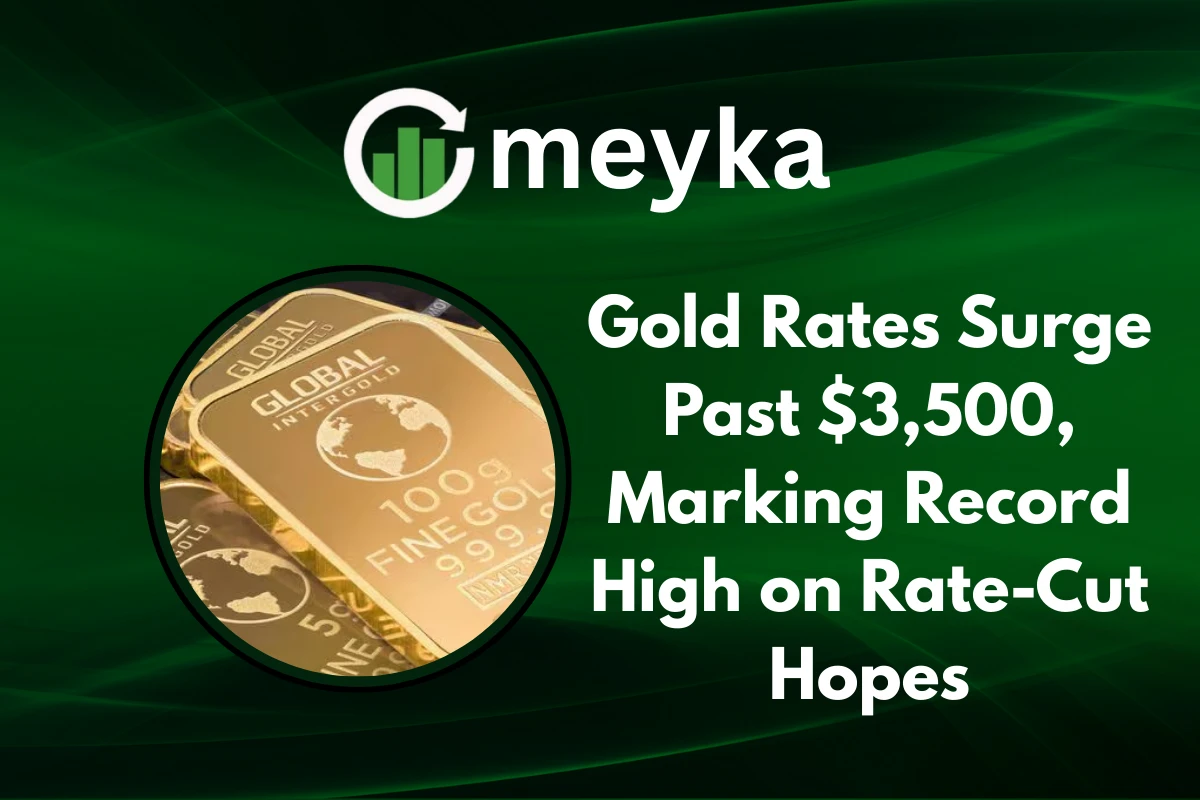Gold Price Today: Gold Rates Surge Past $3,500, Marking Record High on Rate-Cut Hopes
Gold raced to new highs this week, with Gold Rates climbing past $3,500 per ounce as markets ramped up bets that the U.S. Federal Reserve will begin easing policy. The surge pushed bullion into one of its strongest annual rallies in years and lifted silver to its highest levels in over a decade.
Spot bullion reached an intraday peak of $3,508.73 in Asian trade while U.S. futures for later months also jumped. The metal has gained more than 30% year-to-date, underscoring how quickly sentiment can shift in commodities when monetary policy expectations change.
Why are Gold Rates climbing so fast?
Why Gold Rates climbed: Fed rate-cut bets and a softer dollar
Markets are now pricing a high probability of Fed easing in September, with traders putting roughly an 80–90% chance on at least a 25-basis-point cut. Expectations of lower U.S. interest rates reduce the yield advantage of cash and bonds, making non-yielding assets like gold more attractive.
At the same time, a softer dollar lowered the local-currency price for international buyers, amplifying demand.
Political pressure, ETF flows and safe-haven demand
Political tensions around central bank independence and steady ETF inflows added fuel. Analysts pointed to a mix of technical breakouts and renewed institutional interest as drivers. While remarks about Fed independence in the U.S. intensified concerns about future policy trajectory.
“A corollary of the weaker economic backdrop and expectations of US rate cuts is boosting precious metals,” said one market analyst.
What does this mean for global and Indian markets?
Gold Rates hit global and Indian markets hard
The rally played out across both global and local venues. Internationally, gold benchmarks hit fresh peaks and saw strong flows into bullion ETFs and renewed central bank buying. In India, the impact was immediate: MCX futures and spot quotes moved sharply higher, with multiple reports showing domestic prices approaching or surpassing ₹1 lakh per 10 grams. That rapid rise squeezed retail buyers and complicated pricing during the seasonal wedding and festival period.
MCX specifics and silver momentum
On the domestic front, MCX October contracts experienced big intraday swings, with quotes reported around ₹1,00,242 to ₹1,05,300 in different feeds. Silver outperformed, topping $40 per ounce and touching fresh domestic highs, a 14-year milestone, which added to the pressure on jewelers and industrial users.
These moves underline how global dollar-gold dynamics immediately affect local commodity markets.
Should investors buy gold at these levels?
Investor strategies as Gold Rates hit records
Investor views diverge. Short-term traders may chase momentum and volatility, while long-term investors see gold as a hedge against inflation and currency depreciation. Many advisers recommend staggered purchases. For example, using periodic orders or gold ETFs, rather than lump-sum buys at record levels, to mitigate the risk of sharp corrections.
Practical tips and caveats
Traders should use clear stop-loss levels and size positions to reflect risk tolerance. In India, the decision between buying physical jewellery, ETFs, or instruments like Sovereign Gold Bonds depends on liquidity needs and tax treatment.
Advisers often point to SGBs for long-term, tax-efficient exposure while ETFs or spot may suit short-term traders. (This is general information and not financial advice.)
How did markets react in real time?
Real-time reaction and social sentiment
Market commentary and trader reactions were visible on social platforms within minutes. For quick snapshots see these posts:
Commodity watchers in Asia also posted rapid takes:
These reflect the fast-moving nature of price news and the mix of technical and macro reads.
What next for Gold Rates?
Risks and catalysts to watch
Key near-term catalysts include U.S. nonfarm payrolls and inflation prints; stronger numbers would reduce the chance of Fed easing and could trigger a quick pullback in gold.
Conversely, persistent geopolitical tensions, further ETF inflows, and continued central-bank buying would support higher prices.
Traders will watch the dollar index, real yields and Fed commentary closely for directional cues.
Quick facts for traders
- Intraday high: $3,508.73 per ounce.
- Year-to-date gain: >30% in 2025.
- India MCX: Near ₹1 lakh per 10g on key contracts.
- Silver: Above $40/oz, the highest since 2011.
Conclusion: What Gold Rates above $3,500 mean
Gold’s climb past $3,500 signals that markets are heavily anticipating Fed easing and are seeking safety amid political and economic uncertainty. For investors, the development is both a warning and an opportunity: gold can preserve wealth in turbulent times.
But buying at record highs calls for measured strategies and attention to macro data that will determine the next leg of the rally. Watch the Fed, U.S. data and the dollar, they will decide whether this becomes a sustained new baseline or a sharp, tradable spike.
FAQ’S
Gold is surging due to Fed rate-cut expectations, a weaker U.S. dollar, and increased safe-haven demand.
Experts are divided; it depends on U.S. interest rates, inflation, and global economic conditions.
Gold reached a nominal high of around $2,075 per ounce in August 2020.
Adjusted for inflation, gold peaked near $2,800 per ounce during the early 1980s.
Gold is often cheapest in countries with low taxes and import duties, like Hong Kong and Switzerland.
It depends on risk appetite; staggered buying or ETFs may reduce exposure to short-term volatility.
Prices are rising due to monetary easing expectations, geopolitical risks, and strong investor demand.
Prices are rising due to monetary easing expectations, geopolitical risks, and strong investor demand.
Short-term movements depend on U.S. economic data and dollar strength, so predictions are uncertain.
Disclaimer
This is for information only, not financial advice. Always do your research.






